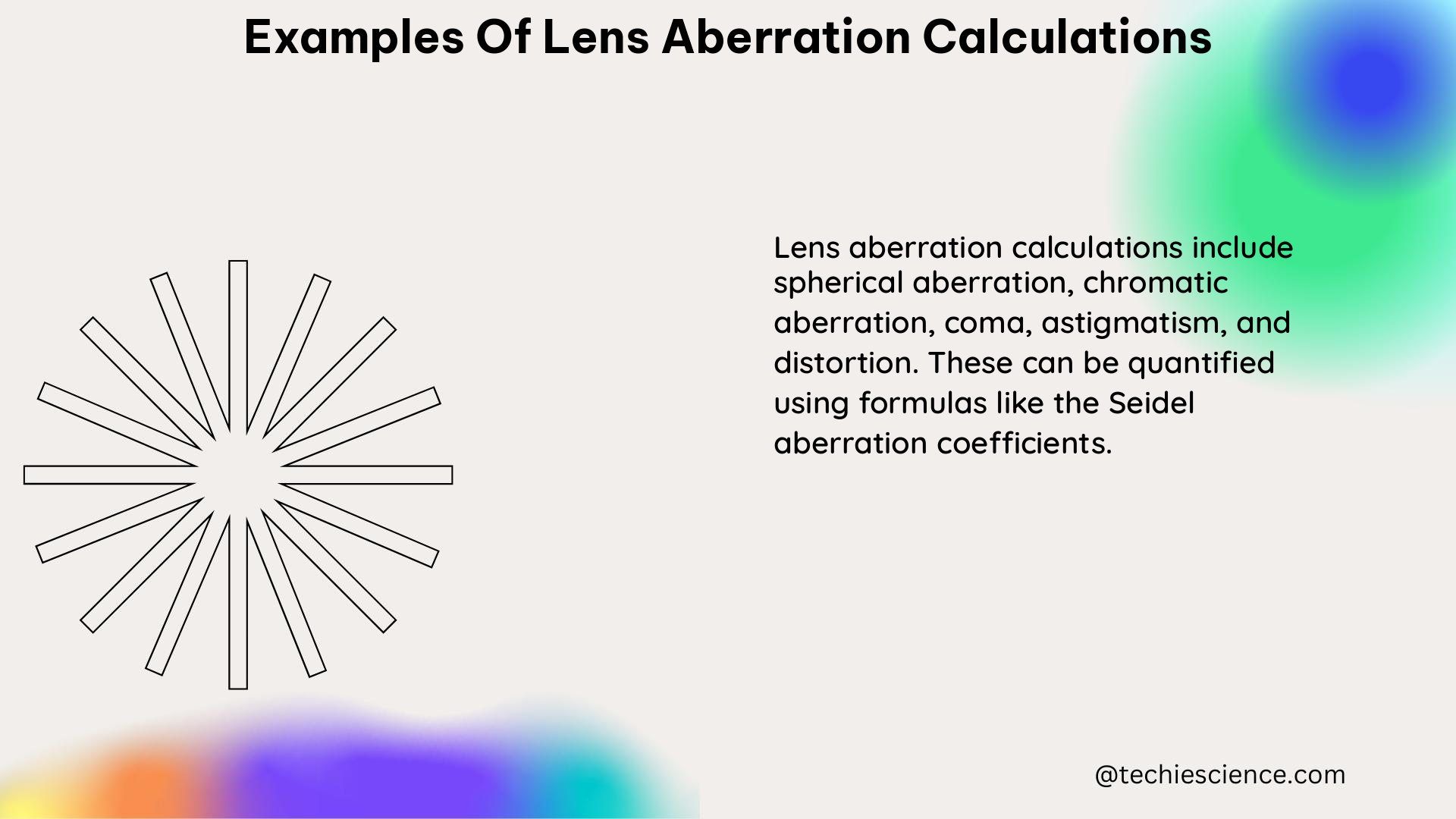Lens aberrations are common optical phenomena that can significantly impact the quality of images produced by camera lenses. This comprehensive guide delves into the technical details of calculating three primary types of lens aberrations: spherical aberration, chromatic aberration, and coma. By understanding the underlying physics and applying the relevant formulas, you can gain valuable insights into the optical performance of your lenses.
Spherical Aberration
Spherical aberration occurs when light rays passing through different parts of a spherical lens focus at different points, resulting in a blurred image. To quantify the amount of spherical aberration, we can use the following formula:
Spherical Aberration = (1/f1) - (1/f2)
Where:
– f1 is the focal length of the lens for light rays passing through the center of the lens
– f2 is the focal length for light rays passing through the edges of the lens
Let’s consider an example:
– Lens focal length: 50 mm
– Lens diameter: 25 mm
– Plugging these values into the formula:
Spherical Aberration = (1/50) - (1/50.04) = 0.000039
This value represents the amount of spherical aberration present in the lens, which can be used to evaluate its optical performance.
Chromatic Aberration

Chromatic aberration occurs when a lens fails to focus different colors of light at the same point, resulting in color fringing around high-contrast edges. To calculate chromatic aberration, we can use the following formula:
Chromatic Aberration = (n1 - n2) / n
Where:
– n1 is the refractive index of the lens material for one color of light
– n2 is the refractive index for another color of light
– n is the average refractive index of the lens material
Let’s consider an example:
– Lens material: BK7 glass
– Refractive index for red light (n1): 1.517
– Refractive index for blue light (n2): 1.522
– Plugging these values into the formula:
Chromatic Aberration = (1.522 - 1.517) / 1.52 = 0.00329
This value represents the amount of chromatic aberration present in the lens, which can be used to evaluate its color correction performance.
Coma
Coma occurs when off-axis light rays are not focused to a single point, resulting in a comet-like blur in the image. To calculate coma, we can use the following formula:
Coma = (D^2 * h) / (16 * f^3)
Where:
– D is the diameter of the lens
– h is the distance from the center of the lens to the off-axis light ray
– f is the focal length of the lens
Let’s consider an example:
– Lens diameter: 50 mm
– Lens focal length: 50 mm
– Off-axis distance: 10 mm
– Plugging these values into the formula:
Coma = (50^2 * 10) / (16 * 50^3) = 0.03125
This value represents the amount of coma present in the lens, which can be used to evaluate its off-axis performance.
Advanced Lens Aberration Calculations
In addition to the examples provided above, there are more advanced techniques and formulas for calculating lens aberrations. These include:
-
Zernike Polynomials: Zernike polynomials are a set of orthogonal functions used to describe the wavefront aberrations in optical systems. They can be used to quantify the various types of aberrations, including higher-order aberrations.
-
Ray Tracing: Ray tracing is a powerful technique for analyzing the behavior of light rays as they pass through an optical system. By tracing the paths of individual rays, you can calculate the various aberrations and their effects on the final image quality.
-
Optical Transfer Function (OTF): The OTF is a mathematical representation of the spatial frequency response of an optical system. It can be used to quantify the overall image quality, including the effects of various aberrations.
-
Modulation Transfer Function (MTF): The MTF is a measure of the contrast transfer characteristics of an optical system. It can be used to evaluate the resolution and sharpness of the final image, which are affected by lens aberrations.
These advanced techniques and formulas provide a more comprehensive understanding of lens aberrations and their impact on image quality. By incorporating these methods into your lens design and analysis, you can optimize the performance of your optical systems.
Reference:
- Techniques for measuring aberrations in lenses used in high-power laser systems
- A Practical Guide to Lens Aberrations and the Lonely Speck Aberration Test
- Aberration-Based Quality Metrics in Holographic Lenses
- Chromatic Aberration: Calculating the Axial Color of a Lens – YouTube
- Lens Aberrations and Ray Tracing

The lambdageeks.com Core SME Team is a group of experienced subject matter experts from diverse scientific and technical fields including Physics, Chemistry, Technology,Electronics & Electrical Engineering, Automotive, Mechanical Engineering. Our team collaborates to create high-quality, well-researched articles on a wide range of science and technology topics for the lambdageeks.com website.
All Our Senior SME are having more than 7 Years of experience in the respective fields . They are either Working Industry Professionals or assocaited With different Universities. Refer Our Authors Page to get to know About our Core SMEs.